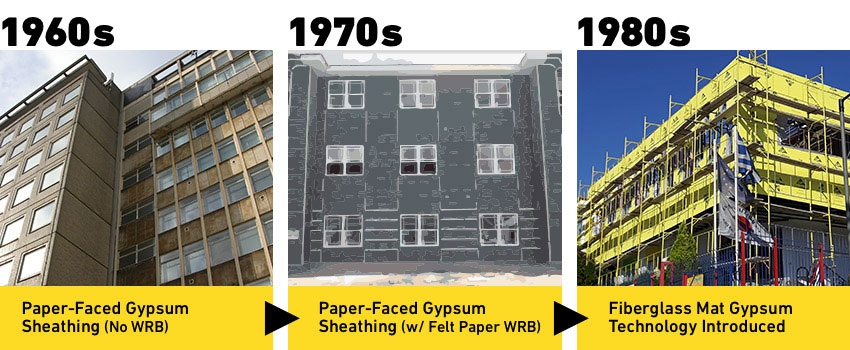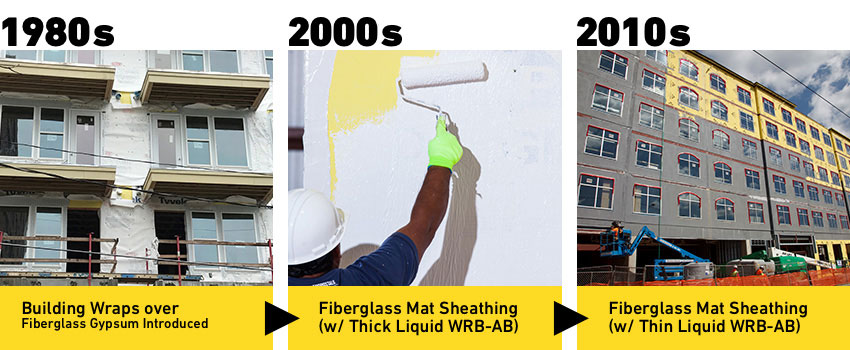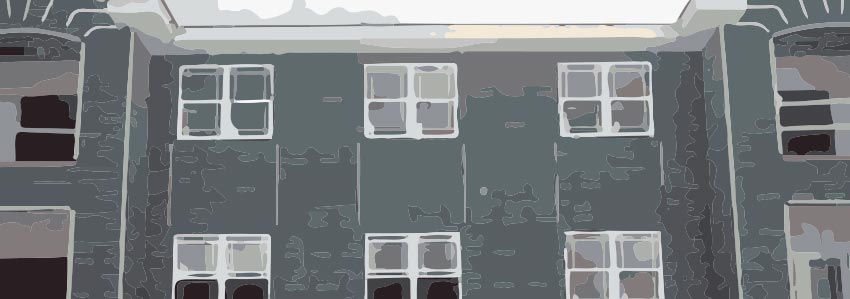The Evolution of Water-Resistive and Air Barriers in Commercial Building Envelope Construction
Evolution of Common WRB and AB Materials
One of the most common building envelope construction types for commercial and residential buildings is based on using wood or metal framing to create exterior walls. That framing is then covered on the outside face with a sheathing panel secured to the framing studs with openings cut as needed for windows, doors, and other openings. This sheathing has formed the basis for most of the water resistance and air resistance in wall assemblies since the 1960s. In commercial construction, the most common sheathing that has been used are gypsum-based products, which are recognized by codes to serve as air-barrier materials. In order to make that air barrier continuous as well as create a full water-resistant barrier, there have been a continuous series of innovations over the past six decades that can be summarized as follows.

The evolution of water-resistant and air barriers relied on innovations in different types of sheathing technology in the 1960s, 70s, and 80s.
1960s: Paper-faced gypsum sheathing was the norm without the use of any particular WRB. This provided fire resistance in exterior wall assemblies and a basic air barrier, but problems related to water and moisture emerged, including delamination of the paper.
1970s: Asphalt-saturated felt paper was identified in building codes to be installed as a WRB. Today, it is still the only code-listed product for a WRB while allowing others that meet tested performance criteria. While adding felt paper over gypsum board is effective at shedding water and protecting the paper surface, it is not effective as an air barrier, meaning that the joints and seams of the gypsum panels all needed to be sealed.
1980s: As concerns about energy conservation and product durability emerged in the 1980s, several innovative products came onto the market. The first was gypsum board sheathing that replaced the paper facing with a fiberglass mat facing. This meant that the amount of time that gypsum sheathing could be exposed to normal weather was dramatically increased compared to paper-faced sheathing. The fiberglass mat surface also provided a basic but effective WRB surface. The second innovation came in the form of fibrous building wraps used on both residential and commercial construction to create primarily an air barrier, although some provided a WRB as well.

Innovation of water-resistant and air barriers continued with the development of specialty products during the 1980s through to today.
1990s: A number of other rigid board stock products emerged on the market to act as a sheathing or substrate behind cladding on an exterior wall. In some cases these were fiber-based products, and in other cases they were variations on rigid insulation boards. Some purported to be able to provide multiple barriers, including WRB, AB and thermal barrier properties. Most needed to be covered promptly since they could deteriorate quickly in weather, sun, or wind.
2000s: While building wraps remained popular over most sheathings, they had some significant limitations with installation that raised concerns about their ability to be truly continuous. There were also some International Building Code changes in 2006 that required WRBs to be applied to the sheathing. In response, some other materials such as heavier-adhered membranes applied in the field over the sheathing were sometimes used. In other cases, fluid-applied membranes that were sprayed or brushed over fiberglass mat gypsum sheathing became preferred to assure performance. Most of the fluid-applied membranes required a thick, measured layer to be field applied but offered full continuity as both a WRB plus an AB since they could readily conform to any irregularities or variations in the underlying substrate. Adhered membranes were bulky and more labor intensive to install over any irregular areas.
2010s: As the technology for fluid-applied membrane barriers developed, they became more effective, thus allowing thinner applications to be tested, and were shown to be highly effective still as both a WRB and an AB. They were still applied in the field and dependent on the skills of the applicators.
Current: In light of the above evolution, some gypsum manufacturers have developed, and now offer, the latest innovation in this technology, namely, incorporating both a WRB and AB directly into fiberglass-mat-faced gypsum sheathing. In order to assure continuity in an assembly, they also offer a complete system of compatible liquid flashing materials to completely seal joints, seams, openings, penetrations, etc. This reduces the dependence on a field installation for effectiveness while taking advantage of the best properties of all products involved.
While the trend of improvement and innovation is clear in this area, not all design professionals have kept up with the progression. This puts them at a disadvantage and potential risk for not specifying the best available solution for a particular project. This condition is compounded by the fact that all of the types of products discussed above are still available and used to one degree or another today.
In order to help with an assessment of these different solutions, the following advantages and disadvantages should be considered for each.
- Building wraps and asphalt felt: As products, these have the advantages of working well as either a WRB or AB, and they are well-known, fairly cost-effective, and straightforward to install in almost any weather condition. They are also usually vapor permeable, meaning that any vapor trapped within the assembly can escape back out through them. Their disadvantages lie not in the product, then, but in their installation during construction. All require fasteners or staples to hold them in place, which causes holes that compromise their ability to act as a WRB. They are also difficult to seal in order to create a truly continuous AB. And as anyone who has visited a construction site where building wraps are left exposed can attest, they are prone to flutter in the wind, which can create larger holes, rips, tears, or complete separation.

Asphaltic felt paper is the only water barrier specifically mentioned in building codes although other products that can demonstrate equivalent, tested performance are acceptable as well.
- Fluid-applied membranes: The multiple capabilities of fluid-applied membranes gives them the advantage of potentially acting as both a WRB plus an AB when covering over sheathing. They are widely available, seal continuously around rough areas and openings, and have a fairly quick installation time through spraying or rolling. Their disadvantages are found in the field in the form of weather limitations for application, the possible need for sealing joints and fasteners first, plus the control of the application thickness for uniformity and effectiveness. They also require careful review of the manufacturer’s information to be sure that permeability and performance match expectations.
- Adhered membranes: Installing an adhered membrane over sheathing may provide both WRB plus AB protection in a consistent, manufactured thickness. Since adhesives are used, no fasteners are required and no joint sealing is needed ahead of time. They have the disadvantages of being more labor intensive to cut and install the membrane, usually require a primer first for good adhesion, and may be prone to wrinkling or poor adhesion if not installed well. Further, termination mastics and accessories are often needed along with some sequence planning to be sure they are solving moisture problems and not causing them. They also have weather limitations, often create a lot of scrap and waste on-site, and the permeability can be impacted by the primer application.
- Rigid board stock: This type of sheathing, particularly if it has some insulation capabilities, may provide a thermal barrier, WRB, and AB all in one product if the joints are properly sealed and it meets the requirements for continuous insulation defined by codes. It can also be lightweight and easy to install. Their downside comes from the comparatively fragile nature of the materials, which makes them easy to puncture, prone to movement, and with greater potential for compromising the WRB or AB properties. Since many are made of petro-chemical elements, they are prone to burn or melt. They also typically require special fasteners and/or washers for installation.
In short, while all of the above common choices may meet the material requirements for different barriers, a closer look at their installation and suitability for different projects can reveal some significant limitations. They will also have variations in the time they take to install and their corresponding costs. Having considered all of these other options, we will next take a more detailed look at the most current technology—integrated sheathing.









